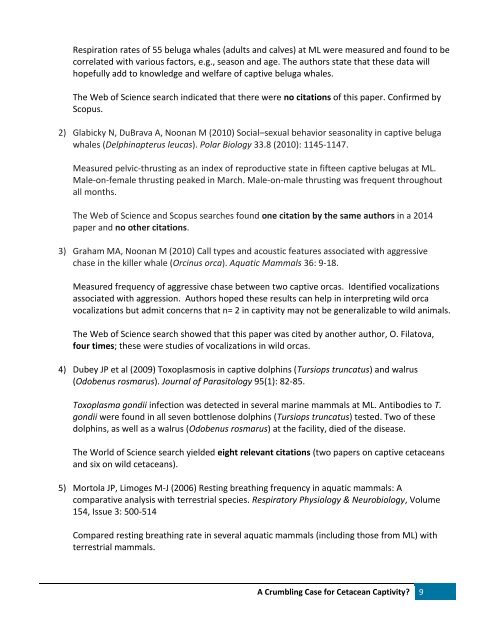A CRUMBLING CASE FOR CETACEAN CAPTIVITY?
MM-Education-and-Conservation-Report-Dec-9-2016-fi
MM-Education-and-Conservation-Report-Dec-9-2016-fi
You also want an ePaper? Increase the reach of your titles
YUMPU automatically turns print PDFs into web optimized ePapers that Google loves.
Respiration rates of 55 beluga whales (adults and calves) at ML were measured and found to be<br />
correlated with various factors, e.g., season and age. The authors state that these data will<br />
hopefully add to knowledge and welfare of captive beluga whales.<br />
The Web of Science search indicated that there were no citations of this paper. Confirmed by<br />
Scopus.<br />
2) Glabicky N, DuBrava A, Noonan M (2010) Social–sexual behavior seasonality in captive beluga<br />
whales (Delphinapterus leucas). Polar Biology 33.8 (2010): 1145-1147.<br />
Measured pelvic-thrusting as an index of reproductive state in fifteen captive belugas at ML.<br />
Male-on-female thrusting peaked in March. Male-on-male thrusting was frequent throughout<br />
all months.<br />
The Web of Science and Scopus searches found one citation by the same authors in a 2014<br />
paper and no other citations.<br />
3) Graham MA, Noonan M (2010) Call types and acoustic features associated with aggressive<br />
chase in the killer whale (Orcinus orca). Aquatic Mammals 36: 9-18.<br />
Measured frequency of aggressive chase between two captive orcas. Identified vocalizations<br />
associated with aggression. Authors hoped these results can help in interpreting wild orca<br />
vocalizations but admit concerns that n= 2 in captivity may not be generalizable to wild animals.<br />
The Web of Science search showed that this paper was cited by another author, O. Filatova,<br />
four times; these were studies of vocalizations in wild orcas.<br />
4) Dubey JP et al (2009) Toxoplasmosis in captive dolphins (Tursiops truncatus) and walrus<br />
(Odobenus rosmarus). Journal of Parasitology 95(1): 82-85.<br />
Toxoplasma gondii infection was detected in several marine mammals at ML. Antibodies to T.<br />
gondii were found in all seven bottlenose dolphins (Tursiops truncatus) tested. Two of these<br />
dolphins, as well as a walrus (Odobenus rosmarus) at the facility, died of the disease.<br />
The World of Science search yielded eight relevant citations (two papers on captive cetaceans<br />
and six on wild cetaceans).<br />
5) Mortola JP, Limoges M-J (2006) Resting breathing frequency in aquatic mammals: A<br />
comparative analysis with terrestrial species. Respiratory Physiology & Neurobiology, Volume<br />
154, Issue 3: 500-514<br />
Compared resting breathing rate in several aquatic mammals (including those from ML) with<br />
terrestrial mammals.<br />
A Crumbling Case for Cetacean Captivity? 9


